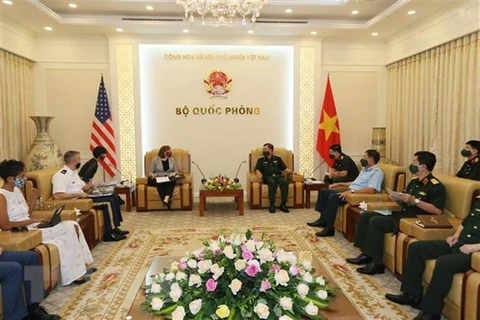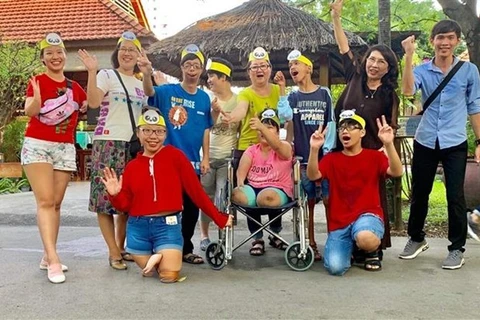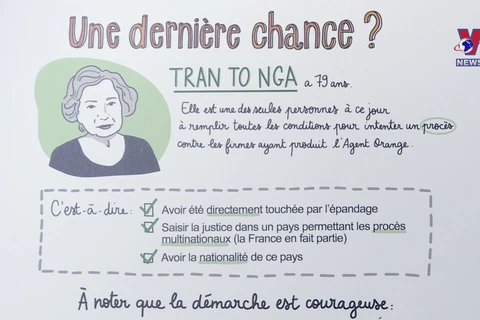Hanoi (VNA) – Great efforts have been made by the Vietnamese Government as well as organisations and individuals at home and abroad to support victims of Agent Orange/dioxin (AO) with a hope to ease the incomparable pain that they are suffering.
In October 1980, the Government set up the Special Committee in charge of investigating the consequences of poisonous chemicals sprayed by the US army during the war (Committee 10-80), aiming to collect full and detailed data on hazardous impacts of the toxic chemicals on human and the environment in affected areas. The committee confirmed various long-time arduous consequences of the lethal poison on the people and environment of Vietnam.
From 1961 to 1971, the US military sprayed about 80 million liters of toxic chemicals, 61 percent of which were Agent Orange, containing 366 kg of dioxin, on nearly a quarter of South Vietnam. About 86 percent of the area was sprayed more than two times and 11 percent of the area more than 10 times.
As a result, around 4.8 million Vietnamese were exposed to the toxic chemical. Many of the victims have died, while millions of their descendants are living with deformities and diseases as a direct result of the chemical’s effects.
In January 2004, the Vietnam Association of Victims of AO/dioxin (VAVA) was officially formed, manifesting the Party and State’s great attention to fixing consequences of toxic chemicals and supporting the victims.
Alongside, many support policies have been issued for revolution contributors as well as AO victims. Meanwhile, Vietnam has exerted efforts to call for engagement from other countries, international organisations and non-government organisations in assisting AO victims with the spirit of “not leaving anyone behind”.
In October 1961, the Ministry of Foreign Affairs of the Democratic Republic of Vietnam (Socialist Republic of Vietnam now) sent a diplomatic note to 103 countries across the world to denounce the US’s crime of conducting chemical war in the south of Vietnam. Many scientists, lawyers, historians and reporters from many countries, including the US, raised their voice against the brutal chemical war launched by the US and its allies in the south of Vietnam.
Right after its inception, the VAVA and a number of Vietnamese Agent Orange/Dioxin victims filed a lawsuit to the US Federal District Court in Brooklyn, New York against 37 US chemical companies that had produced and supplied chemicals to the US military for its use in the war in Vietnam, demanding for justice.
Although the lawsuit was refused by the court, it gave better understanding among people around the world about the AO disaster in Vietnam and its harms to the environment and health of humans in general and those in Vietnam in particular. The struggle lit up an international movement supporting AO victims not only in Vietnam but also in countries engaging in the US war in Vietnam.
Following the lawsuit, in 2015, Tran To Nga, a Vietnamese French and an AO victim, lodged a lawsuit against 26 US firms that had manufactured the toxic AO defoliant used by US forces during the war in Vietnam.
In October 1980, the Government set up the Special Committee in charge of investigating the consequences of poisonous chemicals sprayed by the US army during the war (Committee 10-80), aiming to collect full and detailed data on hazardous impacts of the toxic chemicals on human and the environment in affected areas. The committee confirmed various long-time arduous consequences of the lethal poison on the people and environment of Vietnam.
From 1961 to 1971, the US military sprayed about 80 million liters of toxic chemicals, 61 percent of which were Agent Orange, containing 366 kg of dioxin, on nearly a quarter of South Vietnam. About 86 percent of the area was sprayed more than two times and 11 percent of the area more than 10 times.
As a result, around 4.8 million Vietnamese were exposed to the toxic chemical. Many of the victims have died, while millions of their descendants are living with deformities and diseases as a direct result of the chemical’s effects.
In January 2004, the Vietnam Association of Victims of AO/dioxin (VAVA) was officially formed, manifesting the Party and State’s great attention to fixing consequences of toxic chemicals and supporting the victims.
Alongside, many support policies have been issued for revolution contributors as well as AO victims. Meanwhile, Vietnam has exerted efforts to call for engagement from other countries, international organisations and non-government organisations in assisting AO victims with the spirit of “not leaving anyone behind”.
In October 1961, the Ministry of Foreign Affairs of the Democratic Republic of Vietnam (Socialist Republic of Vietnam now) sent a diplomatic note to 103 countries across the world to denounce the US’s crime of conducting chemical war in the south of Vietnam. Many scientists, lawyers, historians and reporters from many countries, including the US, raised their voice against the brutal chemical war launched by the US and its allies in the south of Vietnam.
Right after its inception, the VAVA and a number of Vietnamese Agent Orange/Dioxin victims filed a lawsuit to the US Federal District Court in Brooklyn, New York against 37 US chemical companies that had produced and supplied chemicals to the US military for its use in the war in Vietnam, demanding for justice.
Although the lawsuit was refused by the court, it gave better understanding among people around the world about the AO disaster in Vietnam and its harms to the environment and health of humans in general and those in Vietnam in particular. The struggle lit up an international movement supporting AO victims not only in Vietnam but also in countries engaging in the US war in Vietnam.
Following the lawsuit, in 2015, Tran To Nga, a Vietnamese French and an AO victim, lodged a lawsuit against 26 US firms that had manufactured the toxic AO defoliant used by US forces during the war in Vietnam.
Nga once worked at the Thong Tan Xa Giai Phong (Liberation News Agency) and exposed to AO/dioxin. Due to the toxic chemical, Nga has suffered many serious diseases, while her three children are also in the same situation. The first died of heart defects and the second suffers from a blood disease. A grandchild of Nga also suffers from AO-related illnesses.
The Crown Court of Evry then rejected the lawsuit due to lack of authority to handle a case related to actions of the US Government during the war. However, Nga affirmed that she will continue to pursue the lawsuit.
The struggle for AO victims’ justice has wakened up the humankind on the harms of dioxin, which has received support by international community.
With the support of a number of governments and international organisations, the Vietnamese Government and Ministry of National Defence have conducted a number of investigations and studies as well as made efforts to deal with AO consequences, contributing to boosting socio-economic development, reinforcing defence-security and creating a stable environment for the national industrialisation and modernisation.
As of June 2021, cooperation projects jointly conducted by the Vietnamese Government, foreign governments and international organisations had detoxified about 90,000 cu.m of dioxin-polluted land, while zoning and safely managing about 50,000 cu.m of less-contaminated sediments in Da Nang airport, thus handing over more than 32 hectares of safe areas to the central city.
More than 7,500 cu.m of dioxin-polluted land in Phu Cat airport of Binh Dinh and 150,000 cu.m in Bien Hoa airport in Dong Nai have also been treated.
Over the years, the US Government has stepped up cooperation with Vietnam in researching the impacts of dioxin, while actively engaging in activities to fix its consequences.
As of May 2020, the US Congress had approved 328 million USD for the US Government to work with its Vietnamese counterpart in settling consequences of dioxin used by the US army during the war in the Southeast Asian nation. By April 2020, more than 80 million USD had been approved by the US for projects to support people with disabilities in Vietnam, including AO victims.
According to the VAVA Central Committee, the two countries will continue to strengthen collaboration in settling AO consequences in Vietnam.
Sen. Lieut. Gen Nguyen Chi Vinh, former Deputy Minister of National Defence, said that among many officials and people from many countries, including American veterans who ever fought in Vietnam as well as senior officials and politicians that he met, none has refused the dioxin disaster in Vietnam caused by the US. They all shared the hope to ease the AO pain in the country, he said, stressing that this is a great motivation for it to gain successful international cooperation in fixing war aftermath./.
VNA

























